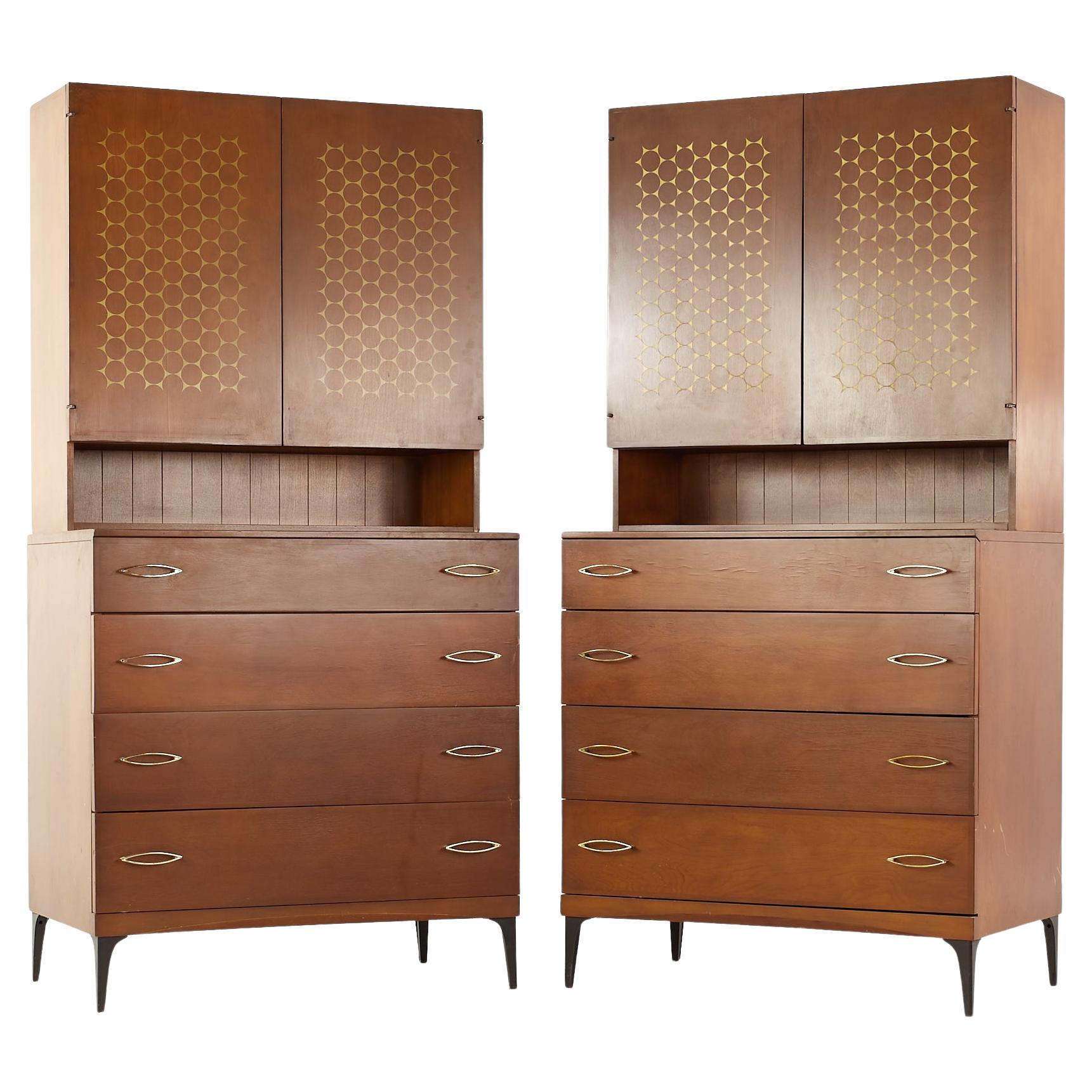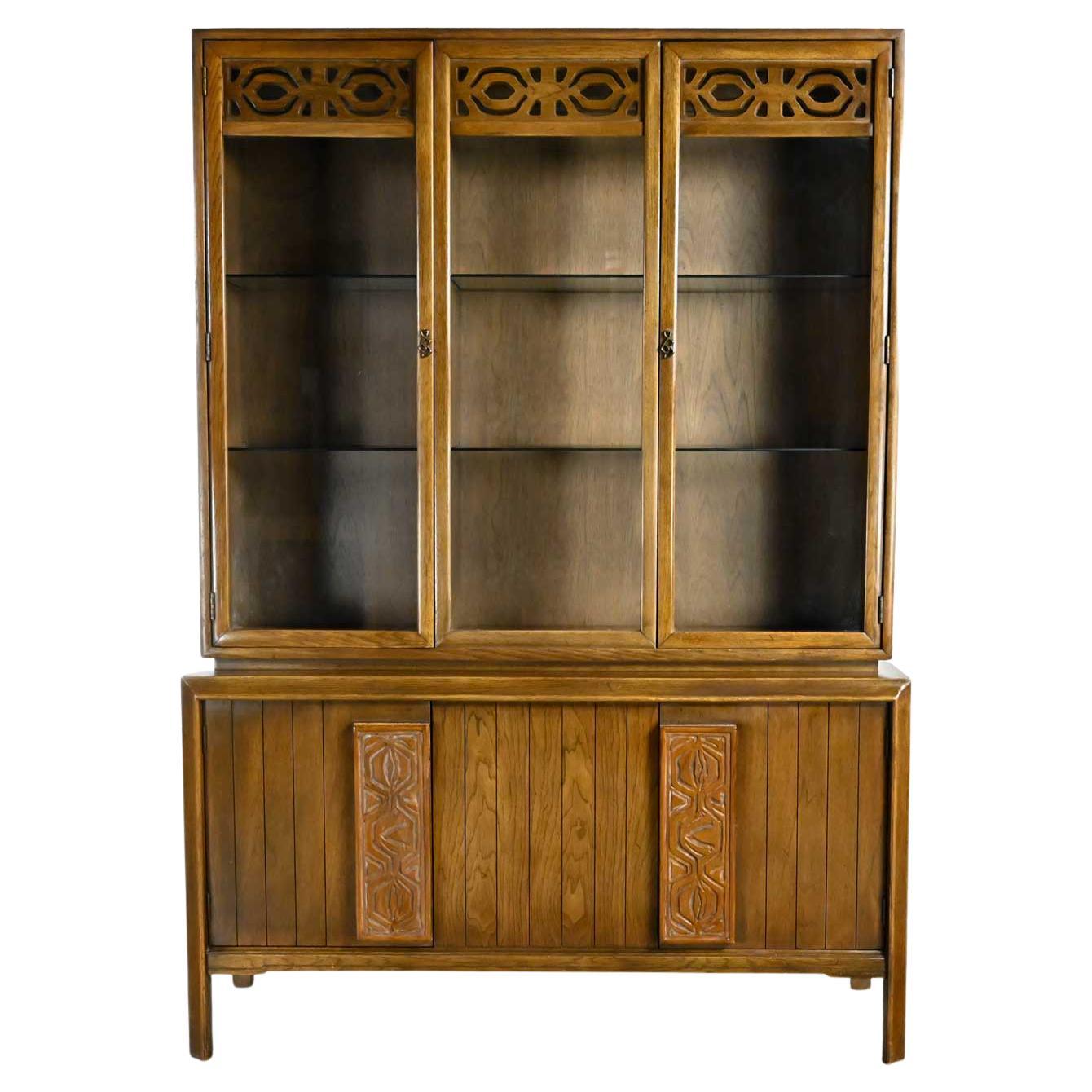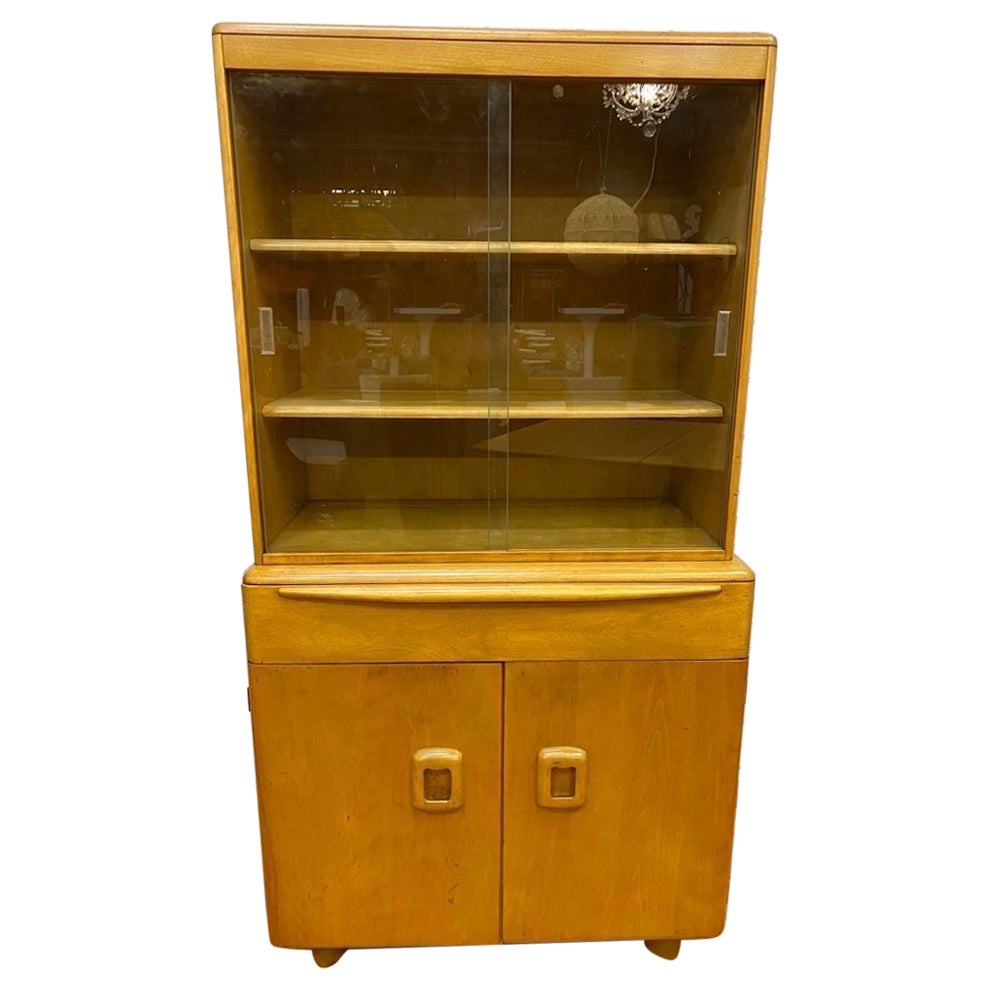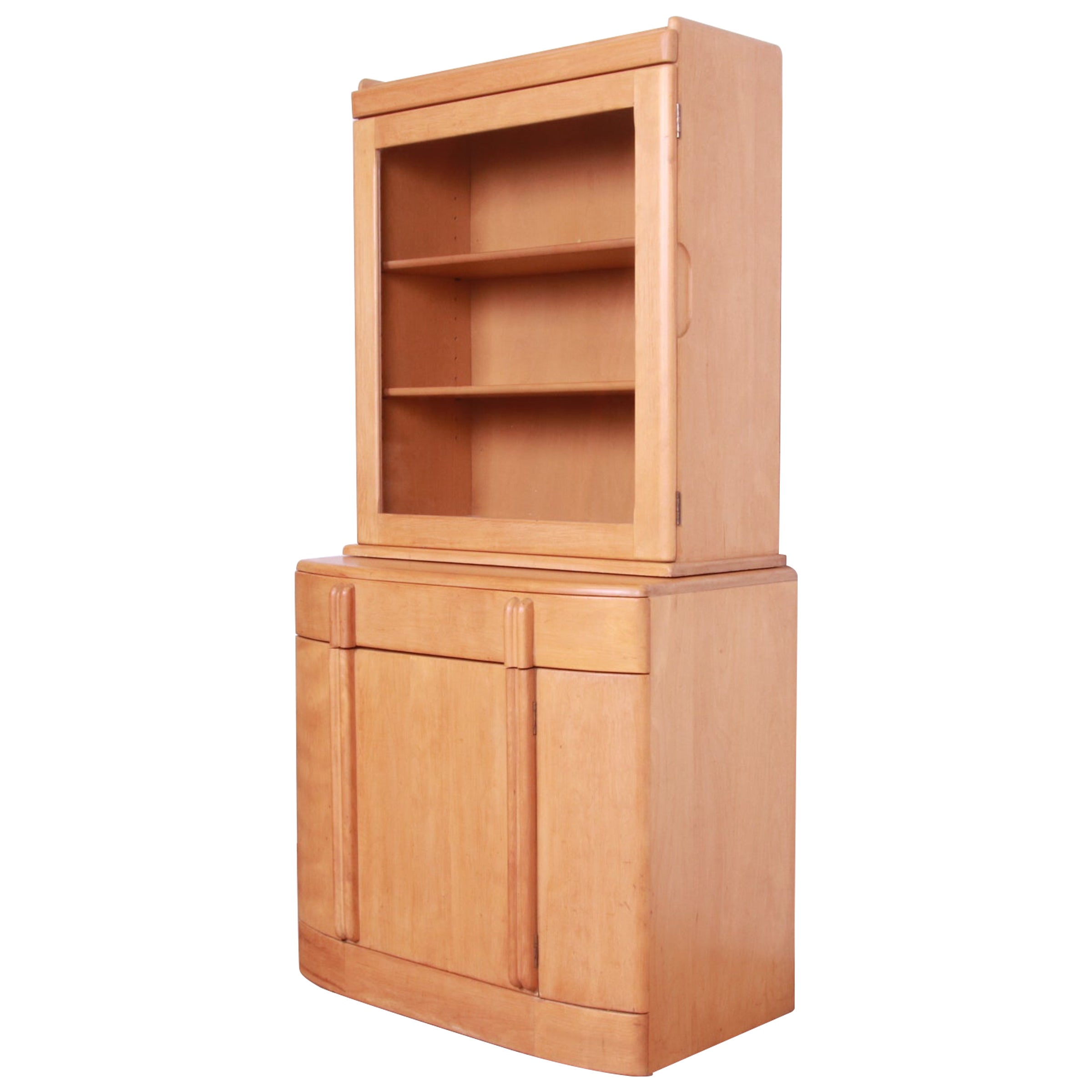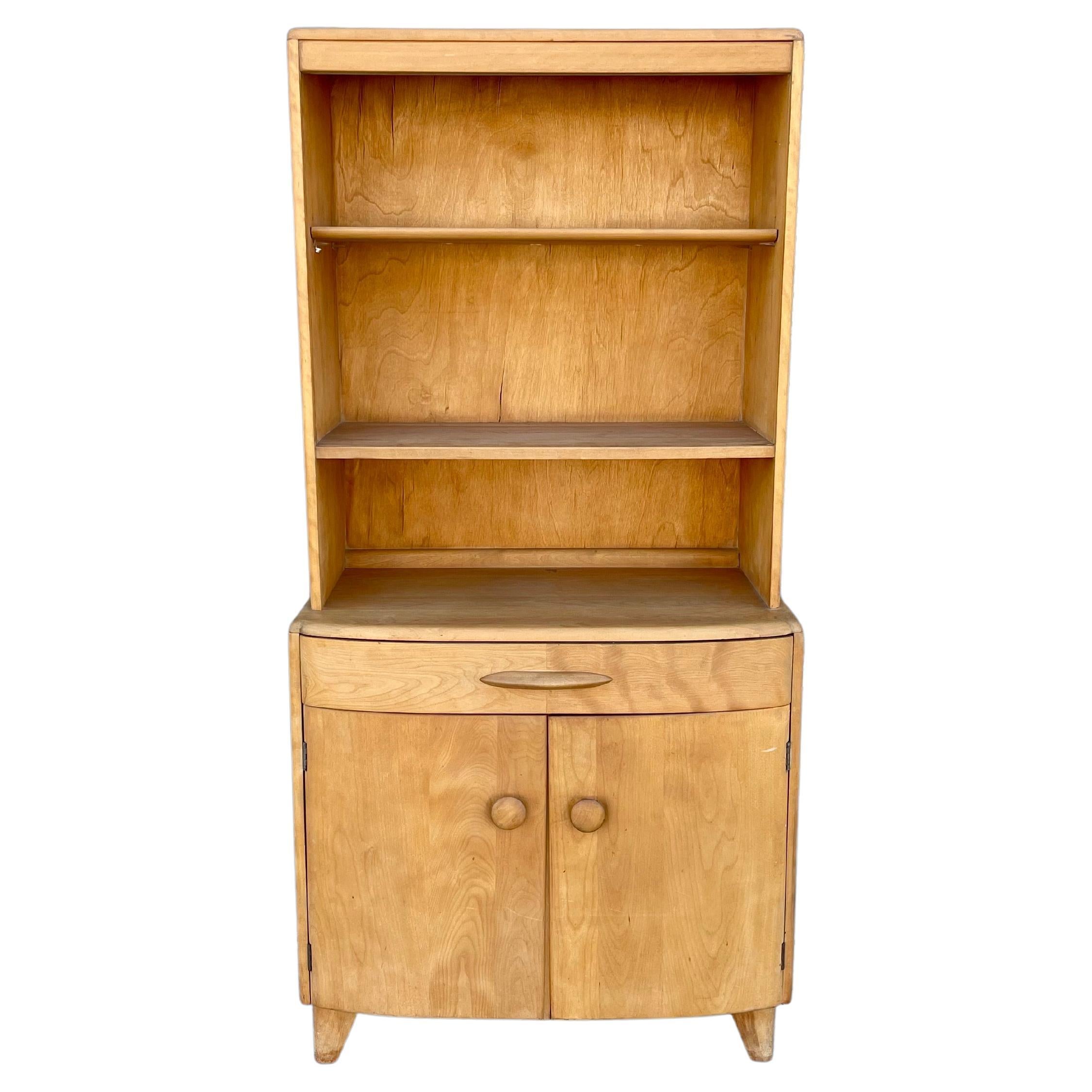MCM 2-Piece China Hutch Cabinet Buffet by Heywood Wakefield Contessa Collection
About the Item
- Creator:Heywood-Wakefield Co. (Designer)
- Dimensions:Height: 76 in (193.04 cm)Width: 60 in (152.4 cm)Depth: 18 in (45.72 cm)
- Style:Mid-Century Modern (Of the Period)
- Materials and Techniques:
- Place of Origin:
- Period:
- Date of Manufacture:circa 1960s
- Condition:Additions or alterations made to the original: Stiffener has been added underneath buffet as the cabinet had sagged in the middle making doors uneven. Stiffener corrected that issue. This work was done by our knowledgeable staff. Wear consistent with age and use. Beautiful vintage condition. There are nicks on left side buffet edge. Touched up. Stiffener was added underneath buffet to correct sag & uneven doors. Please see photos and zoom in for details. We try to show any imperfections.
- Seller Location:Topeka, KS
- Reference Number:
Heywood-Wakefield Co.
Created by the 19th-century merger of two venerable Massachusetts furniture makers, Heywood-Wakefield was one of the largest and most successful companies of its kind in the United States. In its early decades, the firm thrived by crafting affordable and hugely popular wicker pieces in traditional and historical styles. In the midst of the Great Depression, however, Heywood-Wakefield reinvented itself, creating instead the first modernist furnishings to be widely embraced in American households.
The Heywoods were five brothers from Gardner, Massachusetts, who in 1826 started a business making wooden chairs and tables in their family shed. As their company grew, they moved into the manufacture of furniture with steam-bent wood frames and cane or wicker seats, backs and sides. In 1897, they joined forces with a local rival, the Wakefield Rattan Company, whose founder, Cyrus Wakefield, got his start on the Boston docks buying up lots of discarded rattan, which was used as cushioning material in the holds of cargo ships, and transforming it into furnishings. The conglomerate initially did well with both early American style and woven pieces, but taste began to change at the turn of the 20th century and wicker furniture fell out of fashion. In 1930, the company brought in designer Gilbert Rohde, a champion of the Art Deco style. Before departing in 1932 to lead the Michigan furniture maker Herman Miller, Rohde created well-received sleek, bentwood chairs for Heywood-Wakefield and gave its colonial pieces a touch of Art Deco flair.
Committed to the new style, Heywood-Wakefield commissioned work from an assortment of like-minded designers, including Alfons Bach, W. Joseph Carr, Leo Jiranek and Count Alexis de Sakhnoffsky, a Russian nobleman who had made his name in Europe creating elegant automotive body designs.
In 1936, the company introduced its “Streamline Modern” group of furnishings, presenting a look that would define the company’s wares for another 30 years. The buoyantly bright, blond wood — maple initially, later birch — came in finishes such as amber “wheat” and pink-tinted “champagne.” The forms of the pieces, at once light and substantial, with softly contoured edges and little adornment beyond artful drawer pulls and knobs, were featured in lines with names such as “Sculptura,” “Crescendo” and “Coronet.” It was forward-looking, optimistic and built to last — a draw for middle-class buyers in the Baby Boom years.
By the 1960s, Heywood-Wakefield began to be seen as “your parents’ furniture.” The last of the Modern line came out in 1966; the company went bankrupt in 1981. The truly sturdy pieces have weathered the intervening years well, having found a new audience for their blithe and happy sophistication.
Find a collection of vintage Heywood-Wakefield desks, chairs, tables and other furniture on 1stDibs.
- ShippingRetrieving quote...Ships From: Topeka, KS
- Return PolicyA return for this item may be initiated within 3 days of delivery.
- MCM 1 Piece Kroehler China Hutch Cabinet Glass Shelves Carved HandlesBy Kroehler Mfg. Co.Located in Topeka, KSLovely Mid-Century Modern one-piece Kroehler china cabinet or hutch with adjustable glass shelves, brass plated sculpted handles and hinges, lig...Category
Mid-20th Century American Mid-Century Modern Cabinets
MaterialsMetal
- Vintage MCM 1 Piece Walnut & Radio Weave Cane Front Lighted China CabinetLocated in Topeka, KSFabulous vintage Mid-Century Modern 1 piece walnut & radio weave cane front lighted China cabinet, hutch, or display cabinet with glass shelves and brass knobs. Beautiful condition, keeping in mind that this is vintage and not new so will have signs of use and wear. It has normal wear and a newly modified recessed black painted base as it encountered water at some point in its life and could not be refinished so we revamped it and modified the base. Please see photos and zoom in for details. We attempt to portray any imperfections. Circa, mid-20th century. MY oh MY… What a spectacular China cabinet!!! This is a wonderful vintage Mid-Century Modern 1 piece lighted China cabinet, hutch, or display cabinet comprised of walnut featuring glass front doors with finger hole grooves in the molding on the top section and radio weave cane front doors with brass knobs on the lower section. It has a newly modified recessed black painted base as it encountered water at some point in its life and could not be refinished so we revamped it and modified the base. It looks wonderful!! There are glass front double doors on the upper left side and a single glass front door on the right. Behind the upper doors is a wood shelf (the bottom of the upper cabinet, top of the lower) with plate grooves and two adjustable glass shelves that run the full length of the cabinet. The lower section has radio weave cane front double doors on the left and a single cane...Category
Mid-20th Century American Mid-Century Modern Cabinets
MaterialsCane, Glass, Walnut
- Mid-Century Modern 1 Piece Walnut Veneer China Hutch Attributed to Garrison FurnLocated in Topeka, KSWonderful mid-century modern 1 piece walnut veneer china hutch, display cabinet, or bookcase Attributed to Garrison Furniture. Beautiful condition, keeping in mind that this is vinta...Category
Mid-20th Century American Mid-Century Modern Cabinets
MaterialsMetal
- Pair Baker Far East Collection Michael Taylor Natural Elmwood Colonnade CabinetsBy Michael Taylor, Baker Furniture Company, Baker Far East CollectionLocated in Topeka, KSWonderful vintage Asian Style chinoiserie Baker Furniture Far East Collection by Michael Taylor pair of cabinets. Comprised of natural ...Category
Mid-20th Century American Chinoiserie Cabinets
MaterialsBrass
- Chinoiserie Hollywood Regency 2 Pc China Hutch Cabinet Tamerlane by ThomasvilleBy ThomasvilleLocated in Topeka, KSHandsome vintage Chinoiserie Hollywood Regency Tamerlane Collection 2 Piece China hutch or display cabinet by Thomasville Furniture. Comprised of h...Category
Mid-20th Century American Hollywood Regency Cabinets
MaterialsMetal
- Drexel Chinoiserie Campaign Style Off White Lighted Display Cabinet Faux RattanBy DrexelLocated in Topeka, KSLovely vintage Chinoiserie or Campaign style off-white lighted display cabinet with faux wrapped rattan edges by Drexel. Beautiful condition, keeping in mind that this is vintage and not new so will have signs of use and wear. There are a few dings or nicks in the finish and along the bottom edge of piece at floor but nothing major. There is also an overall yellowing or fading to the finish which we consider patina. The inside is purposefully a lighter color than the outside. Please see photos and zoom in for details. We attempt to portray any imperfections. Circa, Mid-20th Century. Is this a marvelous Display Cabinet? Yes! What about a stunning Bookcase? Yes! Could it be a wonderful China Hutch? Also, YES!! This gorgeous cabinet is comprised of a one-piece off-white painted unit with four lower doors (or 2 double doors) with antiqued brass plated rings or handles and open storage with a shelf behind each set of double doors. The top portion is lighted and features two tall narrow double doors with glass...Category
Mid-20th Century American Campaign Cabinets
MaterialsMetal, Brass
- Heywood Wakefield Contessa Mid Century 2 Door Cabinet with Hutch, PairBy Heywood-Wakefield Co.Located in Countryside, ILHeywood Wakefield Contessa mid century 2 door cabinet with Hutch - Pair Each cabinet measures: 30 wide x 18 deep x 31.5 inches high Each...Category
Vintage 1970s American Mid-Century Modern Cabinets
MaterialsWood
- Heywood Wakefield Contessa Mid Century 4 Drawer Cabinet with Hutch - PairBy Heywood-Wakefield Co.Located in Countryside, ILHeywood Wakefield Contessa Mid Century 4 drawer cabinet with Hutch - Pair Each cabinet measures: 30 wide x 18 deep x 31.5 inches high Ea...Category
Vintage 1970s American Mid-Century Modern Cabinets
MaterialsMetal
- Vintage Mid Century Modern Heywood Wakefield Buffet Server Hutch Display CabinetBy Heywood-Wakefield Co.Located in Chicago, ILVintage Mid Century Modern Heywood Wakefield Buffet Server Hutch Display Cabinet Feating mid century modern display buffet cabinet. The top has double glass sliding doors with 3 sh...Category
Vintage 1950s American Mid-Century Modern Cabinets
MaterialsGlass, Wood
- Leo Jiranek for Heywood Wakefield "Airflow" Buffet Hutch or Bar Cabinet, 1930sBy Heywood-Wakefield Co., Leo JiranekLocated in South Bend, INA gorgeous Art Deco or Mid-Century Modern bar cabinet or sideboard server with glass front hutch By Leo Jiranek for Heywood Wakefield, "Airflow" S...Category
Vintage 1930s American Art Deco Sideboards
MaterialsGlass, Maple
- Heywood Wakefield Compact Bar or Cabinet BookcaseBy Heywood Brothers & Co.Located in Wichita, KSWonderful smaller Heywood Wakefield cabinet - originally marked as a bookshelf but can be used as a bar or a sideboard in many ways. The fini...Category
Mid-20th Century American Mid-Century Modern Cabinets
MaterialsWood
- 1960s Mid Century Hutch by Heywood WakefieldBy Heywood-Wakefield Co.Located in North Hollywood, CAMid-century cabinet designed and manufactured by Heywood Wakefieldcrica 1960s. This stunning cabinet features a maple frame that easily separates into two pieces, making it easy to t...Category
Vintage 1960s American Mid-Century Modern Cabinets
MaterialsMaple

